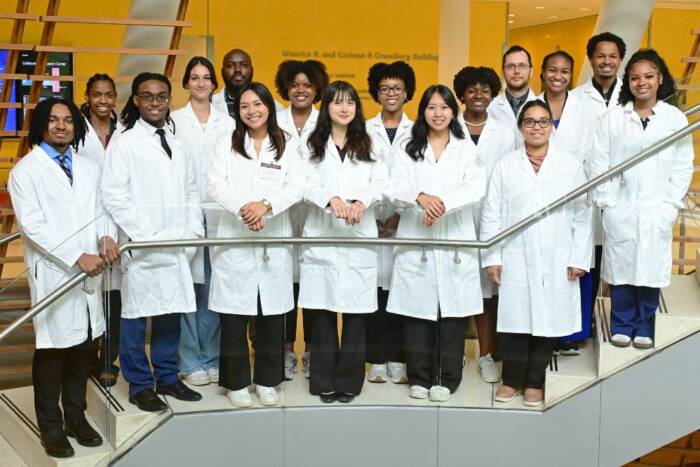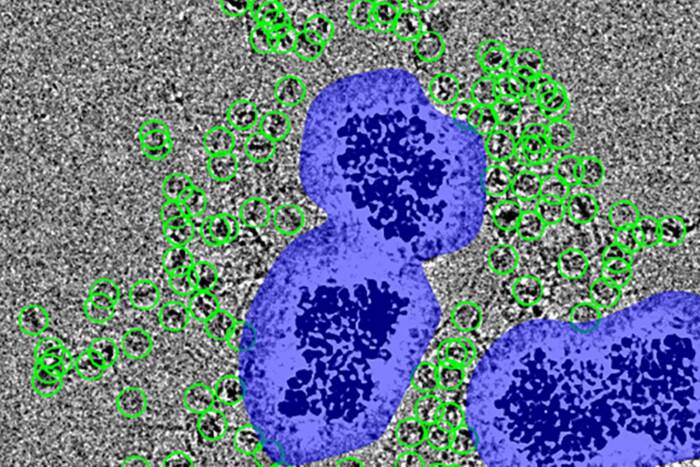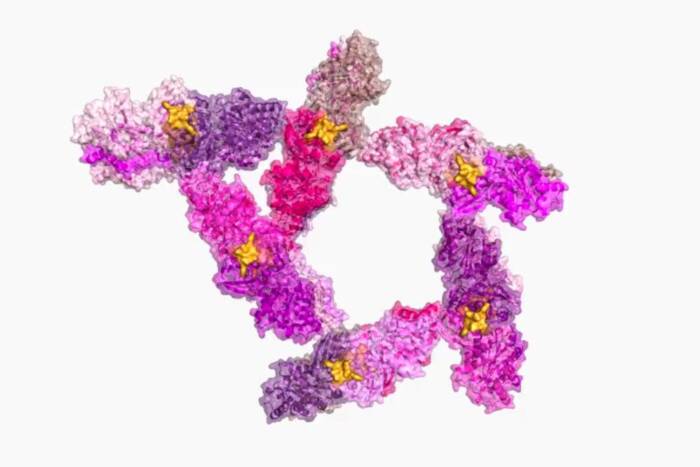Three Leading New York Institutions Announce $160 Million Joint Investment in Biological Research
 NEW YORK, June 27 — Three of New York’s leading research institutions announced the creation of a $160 million collaborative program in basic biological research sparked by a private donor who will contribute half the total investment.
NEW YORK, June 27 — Three of New York’s leading research institutions announced the creation of a $160 million collaborative program in basic biological research sparked by a private donor who will contribute half the total investment.
The collaboration among Cornell University, its Weill Medical College, Memorial Sloan-Kettering Cancer Center, and The Rockefeller University will include the joint recruitment of a dozen new faculty members, reflecting the level of investment demanded by the technological demands of science today.
The joint venture was announced at a news conference this morning at Rockefeller by Arnold J. Levine, president of Rockefeller; Harold Varmus, president of Memorial Sloan-Kettering; Hunter Rawlings, president of Cornell University. Also speaking was Lisa Staiano-Coico, senior associate dean for research at Weill Cornell, representing Antonio Gotto, dean of the medical college, who was out of the country.
 “This new and unique institutional collaboration of these outstanding research centers will allow us to take on the most exciting intellectual challenges of the 21st Century: how to utilize the full knowledge of the human genome and how to apply new technologies in structural biology and nanotechnology to advance human health,” Rawlings said. “Each of our institutions brings unique talents and resources to our partnership so we are a good fit, For example, the Cornell Theory Center in Ithaca, which houses our supercomputer, will play a significant role in this venture.”
“This new and unique institutional collaboration of these outstanding research centers will allow us to take on the most exciting intellectual challenges of the 21st Century: how to utilize the full knowledge of the human genome and how to apply new technologies in structural biology and nanotechnology to advance human health,” Rawlings said. “Each of our institutions brings unique talents and resources to our partnership so we are a good fit, For example, the Cornell Theory Center in Ithaca, which houses our supercomputer, will play a significant role in this venture.”
Rawlings said the new venture was made possible by a lead gift from a private donor.
The joint faculty recruitments will occur over the next five to 10 years. These joint appointees will have full faculty privileges at each of the partner institutions, reflecting a new level of cooperation necessitated by the demands of science today. Visiting investigator programs and enhanced telecommunications links will facilitate collaborations among investigators based in Ithaca and Manhattan. In addition, plans are being developed for a shared graduate program.
The partner institutions will create core facilities for fundamental technologies such as high-performance computing, physical analysis of molecular structure, light and electron microscopy, DNA sequencing and other tools for genetic analysis and the broad range of chemical techniques that are applied to biology.
Among the unique aspects of the partnership will be its group governance by the leaders of each institution. Laboratory space will also be shared, and each of the institutions is now examining the feasibility of developing new laboratories.
 “This is a remarkable time in the history of biology and in the history of our institutions. The technological requirements for fully utilizing our new understanding of the human genome extend beyond the discipline of biology and the boundaries of any single institution,” Varmus said, “and we recognize that New York’s strength in the scientific arena depends on our ability to work together.”
“This is a remarkable time in the history of biology and in the history of our institutions. The technological requirements for fully utilizing our new understanding of the human genome extend beyond the discipline of biology and the boundaries of any single institution,” Varmus said, “and we recognize that New York’s strength in the scientific arena depends on our ability to work together.”
The three areas targeted for development are:
Chemical biology: A new generation of drugs will be precisely targeted to block or reverse disease processes at the molecular level. Development of these new therapies will depend on collaborations among chemists, cell biologists and biophysicists who study protein structure. These integrated teams will play an essential role in realizing the potential of the Human Genome Project, particularly in the analysis and categorization of the proteins coded by the full set of human genes.
Computational biology: High-throughput methods such as those employed by the Human Genome Project are producing massive quantities of data that remain in a disorganized state. Collaboration among computer scientists, mathematicians, physicists, engineers and biologists is needed to identify functional connections among genes and to work toward eventual applications in the diagnosis, treatment and prevention of human disease.
Cancer biology: Under the cooperative venture, cell and developmental biologists will invent and apply new technologies to understand how healthy cells grow and differentiate, and how the disruption of normal processes can lead to tumor formation. The participating institutions will expand their programs in cell and developmental biology, with an emphasis on developing and applying techniques for chemical intervention in cellular processes and real-time imaging of living cells.
“The convergence of disciplines we are seeing today has its own momentum, but we can help it along with strategic planning,” said Levine, Rockefeller’s president. “We must provide researchers with the financial and technical resources they need to achieve the breakthroughs that will lead to new applications for the patient.”
More than 20 faculty members from each of the institutions played a role in developing the program. Some initial steps have already been taken, including a multi-institutional scientific seminar on chemical biology hosted by Rockefeller. A second seminar on computational biology will be held July 22 at Cornell’s Ithaca campus. Joint recruitment is also underway for specialists in bio-informatics.
The partner institutions have undertaken previous successful collaborations. In 1991, for example, they came together to create a tri-institutional MD-PhD program funded through the National Institutes of Health that is one of the most highly rated training programs in the country.
FOR ADDITIONAL INFORMATION CONTACT:
Cornell University: Linda Grace-Kobas
607.255.4206
Weill Medical College: Myrna Manners
212.821.0563
Memorial Sloan-Kettering Cancer Center: Avice Meehan
212.639.3580
The Rockefeller University: Mariellen Gallagher
212.327.7121
Background on the Collaborating Institutions
Cornell University: As one of America’s top 11 research universities in terms of expenditures (nearly $364 million in fiscal 1998), Cornell conducts cutting-edge science that benefits the nation and world. As the land-grant university for New York State, it stands first in academic research in the state, making its results available through a statewide cooperative extension system. Cornell is home to several national research centers: The Center for High Energy Synchrotron Studies, a high-intensity, high-energy X-ray source for research in physics, chemistry, biology, and environmental and materials sciences; the Cornell Electron Storage Ring, one of the four major high-energy accelerator facilities in the United States; the National Astronomy and Ionosphere Center, which operates the world’s largest radio-radar telescope in Arecibo, Puerto Rico; the Cornell Nanofabrication Facility, which builds ultra-small devices; the National Science and Technology Center for Computer Graphics and Scientific Visualization, which develops new computer graphics techniques for visualizing medical, architectural, and scientific data; the Cornell Nanobiotechnology Center, which is developing tiny devices and instruments for biological research; and the USDA-ARS Center for Bioinformatics and Comparative Genomics, which provides agricultural genomics data and resources. The university also is home to the New York State Center for Advanced Technology in Biotechnology, a collaboration between Cornell, New York State, the federal government, and a consortium of industries.
Joan and Sanford I. Weill Medical College of Cornell University: Founded in 1898, Cornell University Medical College (now known as Joan and Sanford I. Weill Medical College of Cornell University) has long ranked among the leading medical schools in the U.S. From the start, the medical college has followed an educational philosophy that emphasizes the importance of combining a strong basic foundation in the medical sciences with extensive clinical training in patient care. In 1927, the Medical College and The New York Hospital entered into a major affiliation agreement, which culminated with the opening, in 1932, of a unified campus on the Upper East Side of Manhattan. Cornell physicians and scientists are engaged in both basic and clinical research in the cutting-edge areas of genetics and gene therapy, neuroscience, structural biology, AIDS, cancer, and psychiatry, among many others. Cornell’s biomedical investigators are delving ever deeper into the realms of cellular and molecular biology, which hold the secrets both to the normal functioning of the body and the malfunctions that lead to serious medical disorders. In 1998, during its centennial year, Cornell University Medical College was renamed Joan and Sanford I. Weill Medical College of Cornell University to honor long-time supporters Joan and Sanford Weill. In partnership with New York Presbyterian Hospital (New York Hospital merged with Presbyterian Hospital in 1998) and the New York Presbyterian Healthcare Network, Weill Medical College now provides expanded opportunities for students to gain clinical experience in a variety of settings.
Memorial Sloan-Kettering Cancer Center: Founded in 1884 as the New York Cancer Hospital, Memorial Sloan-Kettering Cancer Center is the world’s oldest and largest institution devoted to patient care, research, and education in cancer. The collaboration between clinicians and scientists has long enabled Memorial Sloan-Kettering to play a leadership role in advancing the standards of care for patients with cancer. A comprehensive program of clinical care and research is carried out through its 437-bed hospital and patient-care programs in the tri-state region. The Sloan-Kettering Institute conducts basic biological research in the areas of molecular biology, cell biology, cell biochemistry, immunology and pharmacology. Harold Varmus, M.D., who won the Nobel Prize for Physiology or Medicine in 1989, became Center president in January 2000.


